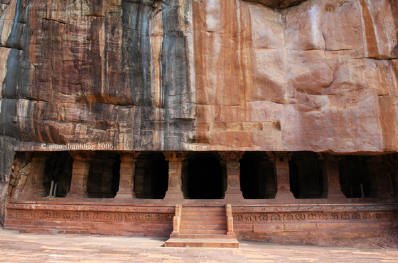|
Badami situated in
North Karnataka, the Capital of the Early Chalukyas. It is noted for
its beautiful carved cave temples, artificial lake , Museme & rock-cut
into the cliff face of a red sandstone hill, of the 6th & 7th Centuries.
It is picturesquely situated at the mouth of a ravine between two rocky
hills. Its all four cave temples - all hewn out of sandstone on the
precipice of a hill. They display the full range of religious sects
which have developed in India. Overlooking the temples is a reservoir,
its banks dotted with temples. Two of them are dedicated to Vishnu, one
to Shiva and the fourth is a Jain temple. The first three belong to the
Vedic faith and the fourth and natural cave is the only Buddhist temple
in Badami. Here are some splendid carvings of the Hindu Pantheon.
Narasimha the half-man half Lion avatar of Vishnu Hari Hara, the
composite god who is half-Shiva and half-Vishnu. Vishnu Narayana sitting
as well as reclining on the snake Shesh or Ananta (Eternity )… There are
also some painting on the ceiling and wonderful bracket figures on the
piers. The caves found here are as follows:
Cave 1:
One can easily climb to cave 1 made of red sandstone. It antedates 578
A.D. and was probably the first to be carved. Climbing the 40 odd steps
to reach the colonnaded verandah, a hall with numerous pillars and a
square shaped sanctum hollowed in the control backwall. Column shafts
are masterfully crafted. On the ceiling one can see the paintings of
amorous couples. Shiva and his consort Parvati, and a coiled serpent.
Shiva as Natraja with 18 arms is seen in 81 dancing poses.
Cave 2:
This cave is dedicated to Vishnu. Vishnu here is depicted as a dwarf or
Trivikrama of awesome dimensions with one foot mastering the Earth and
the other the sky, the second cave is atop a sandstone hill. Vishnu here
is depicted as a dwarf or. Another form of Vishnu portrayed here is as 'Varaha'
or as a boar. Vishnu riding the Garnda & lotus surrounded by sixteen
fishes.
Cave 3:
Still going higher up one comes across this 578 A.D. The facade of the
cave is nearly 70 feet wide, on the plinth one can see the carvings of
ganas. The sheer artistry and sculptural genius makes it this cave the
highlight of Deccani art. It gives a virtual insight into the art and
culture of the 6th century like costumes, jewelry hairstyle lifestyle
etc. The other attractions to be looked carefully in this cave are the
high relief of Vishnu with a serpent, Vishnu as Narasimha (Vishnu as
Man-Lion) Varaha, Harihara (Shiva Vishnu) and Vishnu as Trivikrama.
Cave 4:
Lying to the east of cave three, the fourth cave is Jain. There is an
image of Mahavira adorning the sanctum. Other carvings here are of
Padmavathi & other Thirthankaras. Asteep climb up some steps cut in a
crevice between Cave II & III leads to the southern part of Badami Fort
& to an old gun placed there by Tippu Sultan.
Architure of Temples
The cave temples of Badami which date back to 600 and 700 A.D. are
carved out of sandstone hills. Each has a sanctum, a hall, an open
verandah and pillars. What makes these cave temples remarkable, are the
large number of exquisite carvings and sculptures. The town encompasses
a number of carved monuments and caves of the Chalukyas that is a blend
of Indian Nagara style and the South Indian Dravidian style of
architecture. There are many beautiful murals as well. The free standing
stone temples in Badami, provide enlightening information about the
development of the Chalukyan style of architecture, as many seem to have
been experimental constructions. The early temples appear to be like
large court halls to which shrines were attached. The Ladkhan temple at
Aihole belongs to this early phase. The next phase of development is
visible in the Gowdaragudi temple which is a more complex structure.
One of the many
masterpieces to be found in these caves is the famous, 18-armed Nataraja
(Shiva) who if observed closely, strikes 81 poses. Cave 4, the last
cave, is the only Jain Temple in Badami. The 24th Tirthankara- Mahavira,
is seated in a uniquely comfortable pose here, against a cushion in the
inner sanctum. On the other bank of the ancient Bhutnatha lake, astride
whose shores the caves stand, is the shrine of Nagamma, the local
serpent goddess, within a massive tamarind tree. Nearby, are two Shiva
temples, which deify Him as Bhutanatha, God of Souls. Within the inner
sanctum, on the edge of the water, He sits in a rare pose, leaning back,
in all his awesome majesty. It is said that the better known caves of
Elephanta and Ellora were modelled on the ones in Badami. The
Kailashnatha temple at Ellora, has been hewn out of an entire hillock,
cut out from the parent hill and combines the best of cave and
free-standing temples. |
